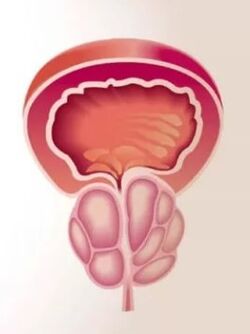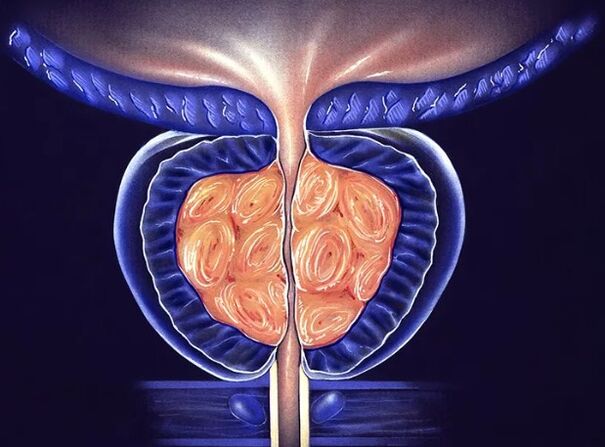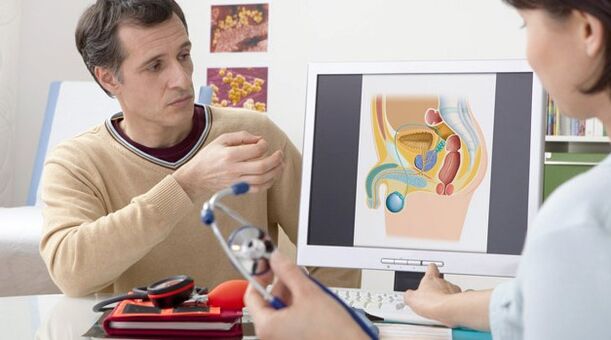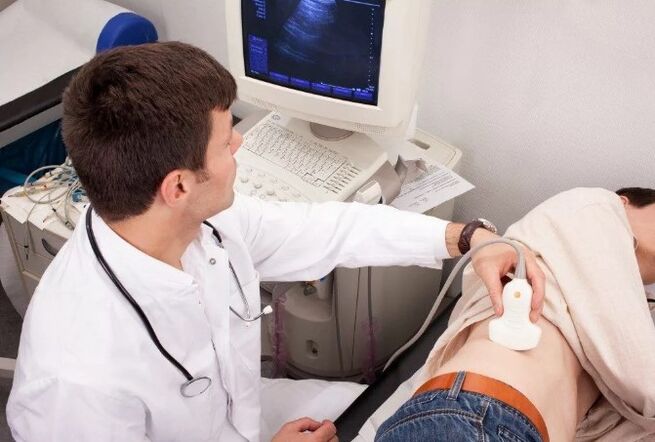Prostatitis is the most common urological pathology in men of reproductive age. According to polls, each third of them at least once in his life experienced symptoms that can be interpreted as inflammation of the prostate gland. Despite such a high occurrence of pathology, prostatitis remains a poorly studied disease.To this day, there is no consensus that it becomes a starting factor in inflammation, because it is possible to distinguish the pathogens of STIs from the genitourinary tract of patients in only 10% of cases.

The absence of clear diagnostic criteria and characteristic signs of the disease complicate the accounting of patients. The symptoms of prostatitis are so nonspecific that each doctor interprets them with a great share of subjectivity and can attribute it to a completely different pathology. Accordingly, the approach to treatment also varies and often patients wander from one hospital cabinet to another without any positive dynamics for years. Prostatitis deprives a man of confidence in his sexual force, hung up his thoughts on one problem and brings him not so much physical as psycho -emotional suffering.
What is a prostate and why is it needed?
The prostate gland (prostate) is a small glandular organ of a man located around the urethra below the bladder. It tightly wraves the urethra, forming one of its sphincters - a muscle jack designed to hold urine. In its form and size, the prostate resembles a chestnut nut, with which it is often compared with anatomists. The part of the urethra, which passes inside the gland is called prostatic. Its rear convex part of the prostate is in contact with the rectum, so it can easily be felt with a rectal finger examination. The front surface of the gland is close to the pubic joint and is connected with it with moving connective tissue ligaments, and the venous plexus lies between them.
The prostate gland consists of lobules, each of which is made by alveoli - small bags lined with secretory epithelium. The alveoli are interconnected by the output ducts in the form of tubes, which merging with each other, enlarge and ultimately fall into the simpletle part of the urethra. Inside the secretory bags, prostatic juice is synthesized and accumulated, which includes nutrients for spermatozoa. It allows male sex cells to maintain its activity in the female body up to 5 days, which significantly increases the chances of fertilization.
Enlightenment of the gland occurs at the time of ejaculation. Prostatic juice is mixed with the secret of the testicles and accounts for 10 to 30% of the final volume of sperm. Thus,The prostate gland performs 2 main functions in the body of a man:
- Participates in the process of urination - holds the urine when the muscle fibers are reduced and freely passes it when they are relaxed;
- Provides the viability of sperm, distinguishing nutrient prostatic juice into ejaculation.

What is the disease developing?
Prostatitis is inflammatory changes in the prostate gland and it should be understood that they arise not only under the influence of bacterial microflora.The causes of inflammation can be any factors leading to damage to the tissue of the gland and the destruction of its cells.
As in any other tissues, the inflammatory process in the prostate proceeds through certain stages:
- Alteration - damage to prostate cells. Squirrels of cytoplasm, fragments of the cell nucleus, and the remains of membranes come out of the destroyed cells into the intercellular space - all of them are a distress signal for the immune system. Immunity cells begin to actively strive for the lesion, penetrating it from blood vessels and connective tissue. They throw biologically active substances in the place of damage, under the influence of which blood vessels expand and cell "reinforcement" comes.
- Exudation - the release of the liquid part of the blood from the vessels.Under the influence of immune cells, the walls of the dilated vessels become permeable to plasma and it rushes into the lesion of the damage. If it is on the surface of a hollow organ or duct of the gland, then the liquid part of the blood is released into its lumen, if the inflammation is tissue, then swelling is formed. Such a measure is necessary to limit the focus of damage and prevent the further spread of the pathogen.
- Proliferation is the replacement of damaged cells with similar ones or connective tissue.The proliferation mechanism is launched a little later than the events described above and its course directly depends on the depth of the damage. Small foci of destruction of the tissue of the prostate gland are replaced by the same functional cells and the organ restores its work in full. Deep disorders are allowed through scarring - the replacement of the dead tissue with connective tissue elements. Chronic prostatitis can ultimately lead to complete atrophy of the prostate gland and the change of its secretory tissue to the cicatricial.

For the proposed reason, prostatitis is divided into:
- Acute bacterial- Pathogenic microflora causes serious damage to prostate tissues with a pronounced inflammatory reaction. Most often it develops with infection with gonococcus and other pathogens.
- Chronic bacterial-Association of pathogenic or conditionally pathogenic bacteria causes sluggish inflammation, the activity of which remains for more than 2 months. As a rule, the pathogens are streptococci, staphylococci, E. coli, Klebsiella, mycoplasma, ureaplasma, chlamydia, herpesvirus, and yeast -like fungus of candidate.
- Chronic abacterial- In the presence of an inflammatory process in the prostate, it is not possible to detect a causal microflora. A similar form of the disease develops when urine is cast into the ducts of the prostate gland, stagnation of venous blood in the pelvis, a violation of its emptying (rare or too frequent ejaculation). In the latter case, the disease is called stagnant prostatitis.
How does the disease manifest?
The most easy to diagnose acute prostatitis,which proceeds with signs of intoxication and pronounced inflammation. In a man, the temperature rises sharply to 38-39 degrees C, pronounced pain in the perineum, in the rectum area, appear. They can give in the groin, in the testicle, to the penis and be so unbearable that the everyday activity of a man is sharply disturbed. In some cases, the body temperature measured in the axillary cavity does not exceed normal indicators, but the rectal in any case will be 1-2 degrees per normal. Signs of prostatitis also become a violation of urination: severe urges to urinate, after which it is impossible to restrain either an acute delay in urine due to severe edema of the gland. Sometimes defecation becomes painful, since the prostate enlarged in size sticks out into the lumen of the rectum.
Chronic prostatitisIn its manifestations, it is so diverse that it can easily be confused with another pathology. In the most typical cases, the symptoms of prostatitis are presented:
- Pain in the crotch, pelvis.It is difficult for the patient to determine a specific place where it is localized, often pain spreads into the groin, scrotum, head and stern of penis, sacrum. Its severity can be different: from barely distinguishable to intense stupid or pulling. Often, pain is associated with urination or ejaculation, occurs at the end or at the beginning of the process.
- Violation of urination- The patient has frequent urges to empty the bladder, he has to repeatedly get up at night to urinate. However, the pressure of the jet is normal, urinary retention develops infrequently.
- Sexual disorders- Against the backdrop of constant discomfort in the crotch of a man, an erection worsens and self -confidence disappears. Violations are aggravated if the pain is associated with the moment of ejaculation: the patient cannot completely relax, as it expects unpleasant sensations.

As a rule, with chronic prostatitis, the general well -being of a man is not disturbed, body temperature is preserved normal throughout the disease.
How is the disease diagnosed?
The diagnosis is established by the doctor urologist or andrologistAfter examining the patient, collecting an anamnesis and studying symptoms. The doctor needs to find out the method of contraception of the patient, the presence of STIs in a sexual partner, the possibility of anal contacts without a condom. These data facilitate the diagnosis and direct the doctor’s thoughts in the right direction. The prescription of the symptoms of the disease or discomfort in the perineum allows us to judge the course of prostatitis and its severity. The urologist necessarily examines the genital organs of the patient and conducts a rectal examination of the prostate gland. To do this, he inserts one finger into the patient’s rear passage and gropes the protruding prostate on the front wall of the rectum. Soreness and its size indicate the intensity of the inflammatory process.

Further, the doctor conducts a number of instrumental, microscopic, bacteriological and immunological studies in order to clarify the cause of the disease. The most common diagnostic method is 4 or 3-glass urine sample. The first method is more time -consuming and difficult to practice in practice, as it requires the patient several times to consciously interrupt urination. The second modification is simpler: the patient continuously urinates into three different containers in equal portions. The first portion speaks of the state of the urethra, the second about the pathology of the bladder and kidneys, from the third, information about the state of the prostate gland is obtained. All collected material is studied under a microscope. With prostatitis in the third portion of urine, leukocytes and sometimes bacteria are found.
Access for the study of prostate and massage when collecting secrets
For microscopy, the secret of the prostate gland is also taken.To do this, the doctor performs a prostate massage through the wall of the rectum for some time so that it is emptied into the urethra. Smops are made from the collected material in the laboratory, painted and studied under a high increase. A sign of inflammation are leukocytes, bacterial etiology of the disease - bacteria in a smear. To determine the type of pathogen, the prostatic secret is sown on nutrient media. If pathogenic microorganisms are present in it, then after 3-5 days they form microbial colonies, which can then be studied by the bacteriological method allows you to obtain data on the sensitivity of microflora to antibiotics.
Of the instrumental diagnostic methods, :
- Ultrasound of the kidneys;
- Trust of prostate with dopplerography - an ultrasonic sensor is inserted into the rectum for the best visualization of the prostate gland, its blood flow is additionally evaluated;
- Rising ugly, is necessary with a stubborn recurrent course of prostatitis. A X -ray contract is introduced into the urethra, after which a number of successive images are performed.

Starting the treatment of chronic prostatitis, you should tune in to a long struggle, since it is not always possible to cure it in a few weeks or even months. It is recommended to combine various methods and tools for therapy, it is useful to enhance drug therapy with households. With stagnant prostatitis, regular sex is needed, interrupted sexual acts are unacceptable. The psycho -emotional background of the patient is important: depression, depression, problems in personal life and sexual sphere are able to negate all the efforts of doctors.
How to prevent?
Prevention of prostatitis includes:
- The use of barrier methods of contraception (condom), especially when it comes to anal sex;
- Timely treatment of STIs;
- Regular sex life, bringing relationships to full ejaculation;
- The prevention of crotch injuries, when classes, traumatic sports should be used by all possible methods of protection;
- Compliance with personal hygiene;
- Ensuring sufficient physical activity.
Despite the fact that today prostatitis is not associated with the risk of developing adenoma or prostate cancer, the disease brings a lot of suffering to its owner. A man exhausted by chronic pain, feeling his sexual weakness, tired of prolonged treatment, changes noticeably externally and experienced doctors define such patients at first glance. To avoid such a fate, you should be careful about your health, carefully protected with every new partner and treat sexually transmitted diseases in time. Prostatitis is not completely treated in all cases, but an experienced urologist is able to significantly improve the patient's condition and the quality of his life.






















